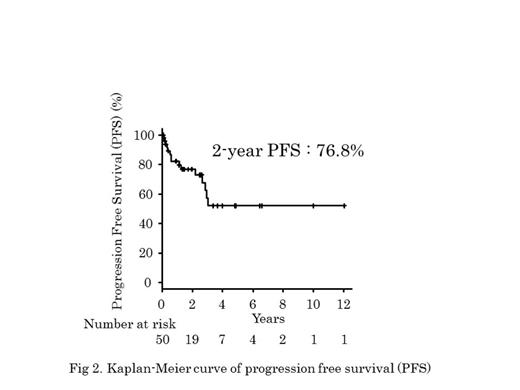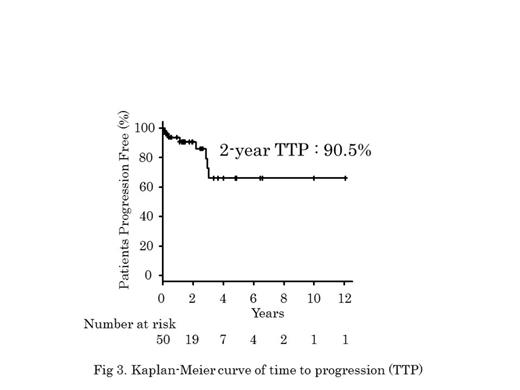Abstract
[Background] Body cavity-based lymphoma (BCBL) arises in body cavity effusion without mass formation. Although there have been several case reports on HHV8-negative BCBL and the term "primary effusion lymphoma (PEL)-like lymphoma" has been coined, it is very rare and not defined in the current lymphoma classification. In those reports, HHV8-negative BCBL usually expresses B-cell markers and the prognosis seems to be better than those with HHV8-positive PEL with a few reports describing spontaneous regression of effusion. However, its clinicopathological features and prognosis remain unclear due to lack of retrospective study with sufficient number.
[Method] We collected data of BCBL diagnosed between 1990 and 2014 from 42 institutions in Japan and clinicopathological features were retrospectively analyzed. We focused on clinicopathological features and prognosis of HHV8-negative BCBL, which was defined as HHV8-negative lymphoma that developed in body cavity effusion (pleural effusion, pericardial effusion, and ascites) without mass formation or extra-cavitary lesions at diagnosis. HHV8 status was assessed with immunohistochemical staining with anti-LANA-1 antibody (n=34) and/or polymerase chain reaction for HHV8 (n=31) of body-cavity effusion sample.Overall survival (OS), progression free survival (PFS), and time to progression (TTP) were calculated using Kaplan-Meier method. In patients without any systemic treatment for 3 months from diagnosis, failure of the first systemic treatment was considered as an event for PFS or TTP.
[Results] Case report form of 71 patients with BCBL was collected. With central review, 4 patients did not meet the criteria of BCBL (existence of tumor mass or no objective evidence of lymphoma by morphology or immunophenotype) and 67 patients with BCBL were identified. Out of them, 50 and 6 were compatible with the diagnosis of HHV8-negative BCBL and PEL, respectively. In another 11 cases, HHV8 status could not be evaluated. In the 50 patients with HHV8-negative BCBL, male to female ratio was 1.3 : 1, and median age at the diagnosis was 76 years (57-98), HIV was negative in all of the 46 patients who were tested. Twenty-four patients (47%) had an underlying medical condition leading to fluid overload such as cirrhosis, cardiac disease, and renal dysfunction. Involved sites were pleural effusion (76%) followed by pericardial effusion (60%), and ascites (12%). Multiple sites were involved in 21 cases. The other clinical characteristics at the time of diagnosis were as follows: ECOG PS 0-1 (50%); B symptoms (14%); and elevated LDH (68%). Tumor cells expressed CD10 in 11/45 and CD20 in 48/50. Immunoglobulin light chain restriction was detected in 28/34. EBER in situ hybridization was positive in 4/32 (13%). The most common first-line systemic therapy was CHOP or CHOP-like with or without rituximab (n=38) followed by rituximab alone (n=2), rituximab with etoposide (n=2), and hyperCVAD/MA (n=1). One patient died within a month before initiating treatment, and five more patients had no systemic treatment at diagnosis for reasons such as comorbidity or frailty. Of the 43 patients treated with systemic therapy, the overall response rate was 98% with 70% achieving a complete remission. With a median follow up of 22 (0-147) months, 2-year OS, PFS, TTP of HHV8-negative BCBL was 83.6%, 76.8%, and 90.5%, respectively (Figure 1-3). Fifteen patients relapsed after achieving response: the same body-cavity effusion alone (n=7), different body-cavity effusion with or without the same site (n=2), intra- or extra-cavitary tumor mass formation (n=6). Eleven patients died and the causes of death were lymphoma (n=8) and others (n=3). Of the 5 patients without systemic treatment at diagnosis, systemic treatment was initiated in only 1 patient at 30 months due to re-emergence of effusion. The remaining 4 patients had had no systemic treatment for a median of 24 (5-147) months and 3 patients were alive without disease without any systemic therapy at last follow-up.
[Conclusion] To the best of our knowledge, this is the largest retrospective study on HHV8-negative BCBL. HHV8-negative BCBL had distinct clinicopathological features from PEL. It affected HIV-negative elderly and the lymphoma cell was positive for B cell markers in most cases. Almost all of the patients responded to systemic treatment and its prognosis was favorable.
No relevant conflicts of interest to declare.
Author notes
Asterisk with author names denotes non-ASH members.




This feature is available to Subscribers Only
Sign In or Create an Account Close Modal